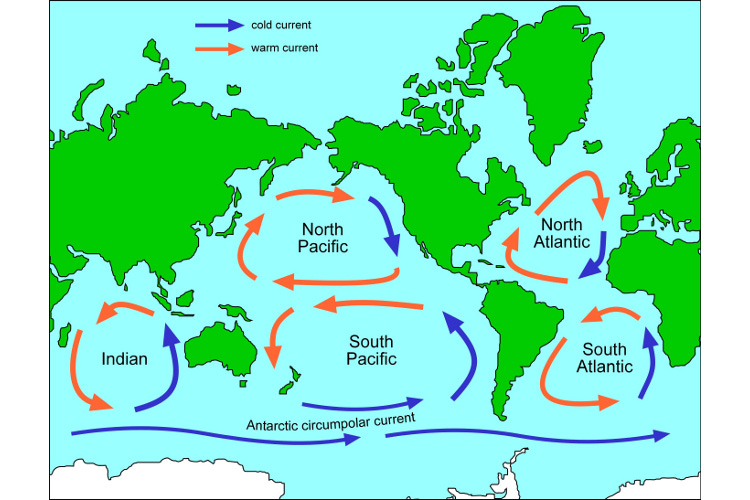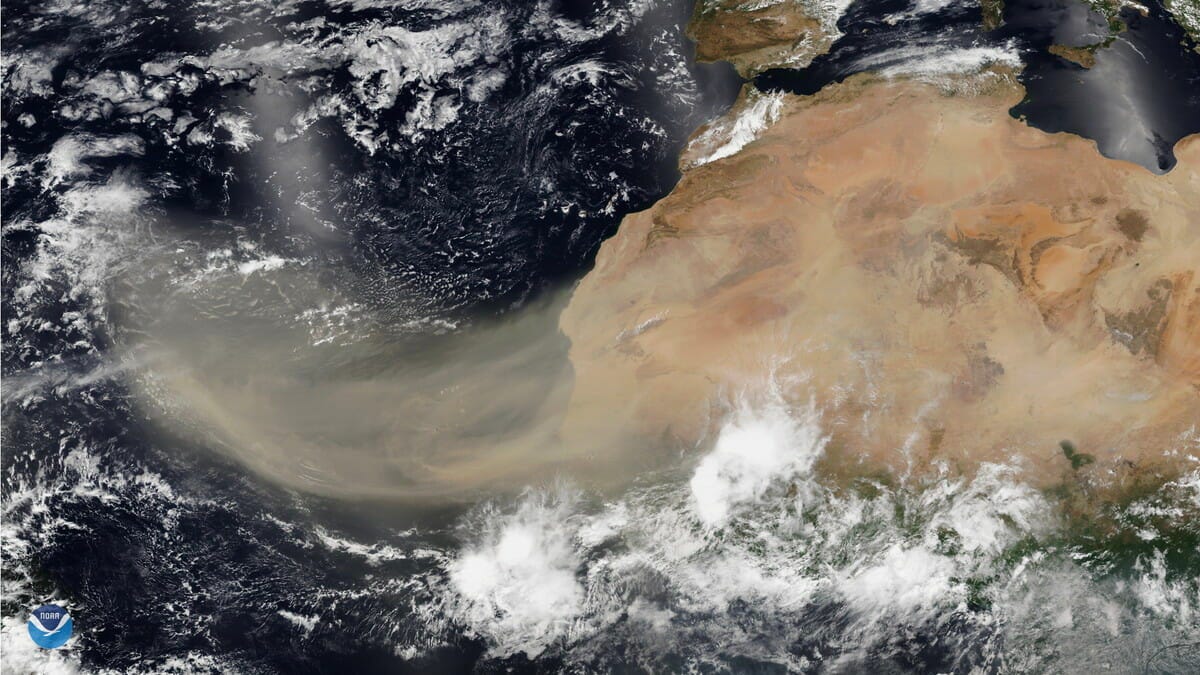A tale of five gyres
Four of Earth’s five warm ocean gyres are marine deserts. The fifth shows what the other four could be.
If you're a normal person, you hardly ever stop to think about ocean gyres: the massive, persistent systems that keep surface waters going round and round the oceans. The energy ocean gyres move is one of the major drivers of Earth’s climate, but they’re unobtrusive enough to be ignored.
The largest of these systems are centered around 30° north and south of the equator. They’re called subtropical gyres, and there are five of them. They flow clockwise in the northern hemisphere and counterclockwise in the southern under the influence of the Coriolis Effect. Normal people may be vaguely aware that they’re there, but they have no clue at all what they could do to address the climate crisis.
Yet the five subtropical gyres are not created equal. Four of them host very little life. In the South Atlantic, the Indian Ocean, and both the North and South Pacific, ocean gyres amount to vast marine deserts.
Scientists, who never waste a chance to use a fancy Greek word when a simple one would do, call them “oligotrophic” gyres — which just means they’re nutrient-poor. The reason is that they’re extremely far from land, so hardly any nutrient-bearing dust reaches them. Iron, especially, but also phosphate and nitrates are in short supply. And without them, there’s nothing to hold up a food web.
In fact, those nutrients are not entirely missing, but the physics of the gyre’s circulation pulls them down away from the surface, like a massive whirlpool. This downwelling effect takes nutrients too far down the water column to sustain photosynthesis. In oligotrophic gyres, the nutrients are where the sunlight isn’t, and the sunlight is where the nutrients aren’t. Tiny photosynthesizers can’t get a foothold in such conditions, so nothing grows.
Some researchers hypothesize that, once upon a time, whales used to do much of the work of ferrying these nutrients from the depths up to surface level, keeping biodiversity going even in oceans that today host almost no life. Then we hunted the whales to near extinction. Now, four of the five subtropical gyres host much less life than they used to.
Then there’s the North Atlantic, the odd gyre out. Sure, some it is barren, like the other gyres. But a large chunk of it isn’t. Instead, it plays host to a huge, richly biodiverse carbon sink. It’s called the Sea of Sargasso.
A kind of underwater Amazon, it’s alive with all kinds of critters, beginning, of course, with the Sargassum itself: a wildly productive seaweed species that sucks CO2 out of the atmosphere at prodigious rates when nutrients are available, and manages to live through the hard times when they aren’t.
It is the only sea named after a living organism that dominates it, and it is enormous, covering an area just a little smaller than the lower 48 American states. It hosts fish, shrimp and crab species that exist nowhere else, and supports large populations of tuna, whales, seabirds, as well as a huge diversity of marine microorganisms. Plus it is, famously, the place where European eels go to spawn.
Which raises the obvious question: why is this one chunk of the North Atlantic full of life — and a prodigious store of carbon dioxide — when the other ocean gyres are mostly barren?
The answer is simple: the Sargasso Sea sits downwind from the Sahara Desert.
Every year, thousands of tons of dust from the Sahara get picked up by the wind and deposited along a wide arc that covers the Atlantic as far as the Gulf of Mexico. The dust carries almost everything ocean photosynthesizers need to thrive: iron, first and foremost, but also phosphate and even some nitrates, which don’t occur naturally in the Sahara but end up there due to human pollution. You can actually see this in satellite images:
It doesn’t quite cover the whole of the North Atlantic gyre. Big chunks of it are still barren. But Saharan dust turns a very large area of the gyre into a teeming biome. Which is one key reason why the North Atlantic sequesters about twice as much carbon per unit area as the South Atlantic.
One way to think about Ocean Fertilization is just as a call to turn the Earth’s four barren ocean gyres into Sea of Sargasso-style carbon sinks: full of life, full of plankton, full of fish, full of whales.
The trick is to mimic the effect of Saharan dust. What nature does for the North Atlantic, people could do for the other four subtropical gyres.
If you’re looking for a benign way to stash away carbon dioxide on a scale large enough to put a dent in climate change, it’s impossible to ignore the oligotrophic gyres.
That their surface waters are nutrient poor is itself a clue about why the could be so useful as carbon stores. Subtropical gyres are huge downwelling systems: the water at the center of the gyre gets gradually pulled down towards the depths. Once the nutrients are down there, they stay down there for a long time. The same physics would do the same thing to carbon. Fertilize a gyre and the currents themselves will end up doing the work of long-term sequestration.
There is no question that we’re talking about a major ecological intervention. Even some people who are minded to support Ocean Fertilization in principle get the heebie-jeebies when proposals get to this scale.
I honestly can’t understand why.
If we can restore the vibrant, complex ecosystems that existed before industrial whaling destroyed them, shouldn’t we? If we can revitalize fisheries and coastal livelihoods, whale habitats and biodiversity hotspots in waters that otherwise just sit idle, shouldn’t we explore that? And if, on top of all that, we end up also creating a massive new carbon sink, how exactly is that bad?
The North Atlantic gyre is just lucky to sit next to a Sahara willing to feed it nutrients all day and all night. The four other gyres could be the same way. Transforming them will require creating a much more fine-grained understanding of the detail of ecosystem restoration. Time’s a’wastin’...




Vote for me and I'll teraform the ocean.
Yes, why not give it a shot? I understand that there could be unforeseen ecosystem impacts, but would they be a show stopper? After all, we have an example in the North Atlantic gyre of what is most likely to happen if we provide nutrients and iron to the other four gyres. Such an intervention might not be perfect, but we can’t let the perfect be the enemy of
the good. The issue is analogous to solar radiation management where we have a natural example in volcanos. The world is running out of time. Desiring certainty is our enemy.